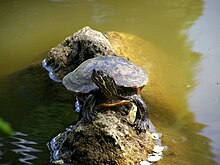Eastern river cooter
| Eastern river cooter | |
|---|---|
 |
|
| Scientific classification | |
| Kingdom: | Animalia |
| Phylum: | Chordata |
| Class: | Reptilia |
| Subclass: | Anapsida |
| Order: | Testudines |
| Suborder: | Cryptodira |
| Superfamily: | Testudinoidea |
| Family: | Emydidae |
| Subfamily: | Deirochelyinae |
| Genus: | Pseudemys |
| Species: | P. concinna |
| Subspecies: | P. c. concinna |
| Trinomial name | |
|
Pseudemys concinna concinna (LeConte, 1830) |
|
The eastern river cooter (Pseudemys concinna concinna) is a subspecies of turtle native to the eastern United States, with a smaller population in the midwest. It is found in freshwater habitats such as rivers, lakes, and ponds.
The eastern river cooter is a subspecies within the species Pseudemys concinna, known as the river cooter. The exact number of subspecies is debated, but most experts recognize two:P. c. concinna, and P. c. suwanniensis. Sometimes another subspecies, P. c. floridana is recognized, but this is often treated as a separate species.
Eastern River Cooters are capable of growing up to 16.5 inches (42 cm). The carapace (upper shell) is typically dark greenish-brown usually with a "C" marking facing the posterior. In western populations, the "C" may be reduced and many yellow markings may be present on each scute The background color is reddish-brown, unlike the other subspecies, P. c. suwanniensis, which is very dark.
The plastron (bottom shell) is yellow to reddish-orange with a dark pattern between scutes that follows the scute seams (this fades with age). This distinguishes it from P. floridana, which lacks the dark marks. The stripe down the hind foot is also a major characteristic, and P. suwanniensis can be distinguished by its lack of color on the legs. Females tend to grow larger than males, and have a smaller tail and more convex plastron.
One particular distinctive feature of the Eastern River Cooter is that they have the ability to breathe underwater through a sac called the cloaca bursae which is based in their tail. This allows them to stay underwater for extended periods of time, and makes their behavior harder to study.
Eastern River Cooters prefer areas with flowing water, such as rivers, but will also live in other freshwater habitats. They live in shallow areas with aquatic vegetation, and when in larger numbers, they live in deeper, clear water.
...
Wikipedia

